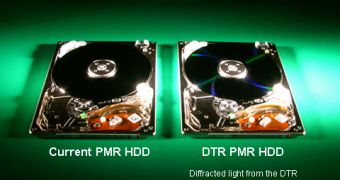Toshiba Corporation announced the launch of a prototype hard disk drive which uses a new recording technology named Discrete Track Recording, that is expected to increase the storage capabilities of all drives by at least 50 percent. The prototype hard disk drive built by Toshiba features a record-breaking capacity of 120GB on a single 1.8 inch recording surface. This drive is the first in the world to implement the DTR technology, which is increasing the area density of the perpendicular magnetic recording, PMR for short, by half. As the prototype hard disk drive is in its early development stages, Toshiba plans to improve the technology and start mass production in the first months of 2009.
The perpendicular magnetic recording technology allows hard disk drive manufacturers to build drives with some pretty high storage capabilities, like the latest Toshiba HDD which features an 80GB of storage room crammed on a single 1.8 inch platter, but when used in conjunction with the DTR technology, the 1.8 inch HDD can store as much as 120GB on a single recording surface. DTR is boosting the recording density by 50 percent, allowing a density of 516 megabits per square millimeter or 333 gigabits per square inch. Another new thing about the Toshiba drive is the servo pattern for tracking control, which is also found on the disk.
On the physical level, the recording surface on a hard disk drive is formed by many tracks and in order to eliminate magnetic interferences between them, manufacturers are spacing them quite widely. This is where the DTR technology comes in, as it is used to create a "groove" between adjacent tracks, which reduces signal interferences and allows the total distance between tracks to be shortened. As the data recording tracks are packed more closely, this allows the placement of more such tracks on the same surface and that coupled with a better signal quality contributes to raising the recording density by 50 percent. The Discrete Track Recording technology utilizes an electron beam lithography system in order to write the data tracks across the recording surface and this process was developed as a part of the "Nanometer-Scale Optical High Density Disk Storage System" research program.
The capacity improvement of the 1.8 and 2.5-inch hard disk drives is very important for the computer manufacturing business, as the total number of the mobile computer systems is rising fast and the laptop and notebook users want the same storage capabilities that are found on typical desktop systems.

 14 DAY TRIAL //
14 DAY TRIAL //